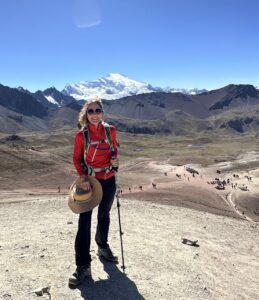Summer Hiking Safety
by Melody Monberg, Hike for Life Operations Manager

If you’ve walked any Colorado trail in summer, chances are you’ve seen signs that say things like “Beware of rattlesnakes” or “Bears active in the area.” Those signs can feel a little spooky—but truthfully? Wildlife is rarely the biggest concern. It’s the everyday stuff that can sneak up on you: dehydration, sunburn, or simply getting turned around.
Twenty years and thousands of trail miles have taught me that it’s rarely teeth or claws that transform an adventure into an ordeal – it’s the ordinary oversights. Even experienced hikers who are sure that they’ve “got it in their pack” have found that this time…it isn’t. The best way to protect yourself on the trail means reviewing a simple preparation checklist, putting eyes on all the gear you need, and usually bringing a bit more than you think.
The Trail-Tested Truth
Dehydration doesn’t always show up with a warning—it sneaks up on you, especially at altitude where your body sweats differently (and dries faster than you realize).
And that strong Colorado sun? It hits harder up here, with less atmosphere between you and it. One minute you’re cruising, and the next you’re wondering if that pile of rocks is a cairn or just… a pile of rocks. Trails that were obvious five minutes ago suddenly vanish into thin air (literally).
Truth is, more hikes get cut short by basic missteps than by bears.
Whether you’re strolling the red rocks or huffing toward a high-altitude view, these five essentials might just save your hike—and spare you a miserable detour.
H.N.P.N.M.: Your Wilderness Survival Alphabet
H – Hydration: Your Primary Currency
Drink up! A good rule of thumb is half a liter of water for every hour on the trail. I like using a water bladder or a bottle with a straw—makes it easier to sip as I go instead of realizing I’m parched halfway up. And here’s a weird little fact I’ve learned the hard way: sometimes when you think you’re starving, your brain’s just asking for water. Sneaky, right?
N – Nutrition: Fuel for the Journey
Hiking uphill turns your body into a calorie-burning machine—fast. Pack easily accessible snacks with complex carbs and protein to keep your energy steady and your head clear. Think trail mix with nuts and dried fruit, nut butter on whole grain, jerky, pretzels, or even gummy bears. The key is to snack before you crash—fuel early, fuel often.
P – Protection: Defend the Body
At elevation, the Colorado sun strikes with particular intensity. The air thins, offering less filtration against UV rays, while the ground reflects additional light upward.
Apply sunscreen before leaving home – SPF 30 minimum, reapplied every two hours. Your future self will thank you when you’re not spending the evening with aloe vera and regrets.
Layer your clothing even when the morning feels warm:
- Base layer that wicks moisture
- Insulating layer for temperature drops
- Waterproof outer layer for mountain showers
I’ve watched afternoon thunderstorms materialize from clear blue skies within minutes. The temperature plummeted twenty degrees as hail bounced off surrounding rocks. Those in cotton t-shirts huddled miserably; those with rain shells continued comfortably.
N – Navigation: Know Your Path
Study the trailhead map before starting. Take a photo with your phone. Carry a physical backup—technology fails precisely when you need it most.
Free apps like COTREX provide Colorado-specific trail information, even tracking your position without cell service. But pack a portable charger; photography and GPS drain batteries quickly. Knowing the right path is everything.
M – Mitigation: Prepare for the Unexpected
The mountain doesn’t care about your plans. Keep a “ready bag” in your vehicle with emergency essentials: extra water, shelf-stable snacks, basic first aid supplies, emergency blanket, headlamp. This simple preparation makes the difference between inconvenience and emergency.
Before heading out, especially in remote areas:
- Tell someone where you’re going and when you’ll return
- Check the weather forecast, including afternoon conditions
- Leave a visible note in your car with your intended route and return time
Mountain weather speaks its own language—learn to read the signs. Darkening clouds with flat bottoms. Sudden wind shifts. Distant rumbling. These aren’t suggestions to wait out the storm; they’re commands to descend immediately.
For more information on the Five Fundamentals, please visit Hike for Life.
The Morning Checklist
Before my boots hit the trail, I run through my essentials–and visually confirm they are in my pack or car. I don’t rely on my memory anymore, if I don’t actually see it… it isn’t there.
- Water (filled and accessible)
- Food (variety for changing conditions)
- Protection (sun, rain, cold)
- Navigation (map loaded, backup printed)
- Emergency supplies (small kit always in my pack)
And the biggest pro tip I could give you–take a little bit more than you think you need. You may not need it, but it’s there. I always keep extra food and water in the car so that I can comfortably eat and drink all of what I bring on the trail knowing that I have plenty more in the car. Also, taking extra means helping out someone who may have not brought enough.
This five-minute check has prevented countless trail mishaps and preserved the joy that draws us to wild places.
The Heart of the Matter
We seek the outdoors not for its hazards but for its healing. The rhythmic crunch of gravel beneath boots. The sudden cooling as you enter a pine forest. The expansion in your chest when you crest a ridge and the world opens before you.
Preparation isn’t the opposite of spontaneity—it’s what makes spontaneity possible. When your basic needs are secured, you’re free to notice the hawk riding thermals overhead or the wildflowers painting the meadow in impossible purples. You can explore that side trail with confidence. Linger another hour by the river, cooling your feet. When you’re prepared, you have more options for adventure.
Stay aware. Stay prepared. Then let yourself settle into the open spaces—where your senses wake up and even familiar trails feel fresh again.
Nature awaits. Go meet it—just remember to bring water.
